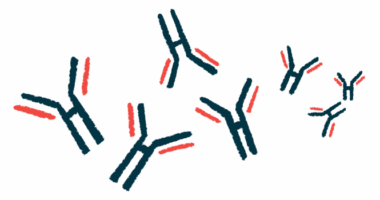Anti-ADAMTS13 antibody levels could help guide TTP treatment
Patients needing additional immunosuppressive therapies may be identified

Levels of anti-ADAMTS13 antibodies measured after therapeutic plasma exchange (TPE) are associated with the time it takes to achieve normalization of ADAMTS13 activity in people with immune-mediated thrombotic thrombocytopenic purpura (iTTP), a study in Hungary shows.
Findings specifically showed that high levels of anti-ADAMTS13 antibodies measured one week after patients stopped TPE upon showing an initial clinical response were associated with a delayed normalization of ADAMTS13 activity. This was seen in patients receiving standard of care treatment alone and in those receiving Cablivi (caplacizumab-yhdp) plus standard of care.
“[This] finding has important clinical implications, as it suggests that measuring post-TPE anti-ADAMTS13 [antibody] levels may help identify patients who need additional immunosuppressive treatment to avoid delayed ADAMTS13 normalization,” researchers wrote.
The study, “High anti-ADAMTS13 IgG levels after plasma exchange predict delayed ADAMTS13 normalization in immune-mediated thrombotic thrombocytopenic purpura,” was published in Thrombosis and Haemostasis.
TTP marked by reduced activity of enzyme that regulates blood clotting
TTP is marked by reduced activity of the ADAMTS13 enzyme that regulates blood clotting. This results in the formation of blood clots in small blood vessels, which can cause organ damage. In iTTP, the immune system produces antibodies that target ADAMTS13, preventing it from working properly.
“The removal of anti-ADAMTS13 antibodies and the restoration of ADAMTS13 activity are central in the therapy of iTTP,” the researchers wrote, noting that this is typically achieved through a combination of TPE and immunosuppressant therapies. TPE is a medical procedure used to remove and replace a patient’s plasma, the liquid component of blood, with that of a healthy donor.
Cablivi is an antibody-based therapy approved for iTTP that prevents blood clots by blocking the interaction between von Willebrand factor (vWF), a protein involved in blood coagulation, and platelets. Although the therapy has been shown to be effective in enabling patients to achieve an early clinical response, some may experience a delayed normalization of ADAMTS13 activity.
“Thus, the identification of patients with a higher risk for delayed ADAMTS13 activity normalization is important,” the researchers wrote.
Significant proportion of patients had delayed ADAMTS13 normalization
To learn more, the researchers conducted a retrospective analysis of people with iTTP at a hospital in Budapest.
Ten patients were treated with Cablivi in addition to standard of care. Another 28 patients received standard of care alone and served as the control group. Patients had a mean age between 39 and 42 years, and were primarily women.
Standard of care included corticosteroids and TPE, which were used in all patients. Most also received rituximab (67.9% in the control group and 80% in the Cablivi group) and some other immunosuppressant therapies (40% vs. 10.7%).
Patients started TPE sessions after the clinical diagnosis of iTTP was established. They discontinued TPE after showing an initial clinical response, defined as a platelet count of 150 billion platelets per liter of blood and no signs of red blood cell destruction for at least two days.
Those in the Cablivi group received Cablivi according to the therapy’s dosing recommendations. The first dose was given by an intravenous, or into-the-vein, injection before TPE. This was followed by daily under-the-skin injections that were maintained for 30 days after the last TPE session.
The total number of TPE sessions until disease remission was significantly lower in the Cablivi group than in the control group (median of 5 vs.11.5), which was associated with the fact that half of the patients in the control group had an exacerbation requiring TPE again, compared with none in the Cablivi group.
High post-TPE anti-ADAMTS13 [antibody] levels may help identify patients who have an increased risk of delayed ADAMTS13 activity normalization and who would thus benefit from eventual additional immunosuppression.
ADAMTS13 activity was significantly lower in patients treated with Cablivi than in controls for almost three weeks after stopping TPE. However, the median time to achieve an enzyme activity level greater than 20% (partial ADAMTS13 remission) was similar in both groups.
Still, a significant proportion of patients presented delayed ADAMTS13 normalization, meaning they required more than 30 days to achieve a sustained partial recovery of ADAMTS13 activity.
The levels of self-reactive antibodies targeting ADAMTS13 decreased after patients started TPE. Higher levels of anti-ADAMTS13 antibodies measured one week after stopping TPE were associated with a longer time to normalize ADAMTS13 activity. Also, the levels of these antibodies were significantly higher in people with delayed ADAMTS13 activity normalization (101.7 vs. 23.4 U/mL).
This indicates that a prolonged persistence of self-reactive antibodies plays a role in delayed ADAMTS13 normalization, according to researchers.
Statistical analyses also indicated that in Cablivi-treated patients and controls, anti-ADAMTS13 antibody levels after TPE were the only significant predictor of delayed ADAMTS13 activity normalization.
“We propose that the anti-ADAMTS13 [antibody] levels should be monitored in [Cablivi]-treated patients. High post-TPE anti-ADAMTS13 [antibody] levels may help identify patients who have an increased risk of delayed ADAMTS13 activity normalization and who would thus benefit from eventual additional immunosuppression,” the researchers wrote.








